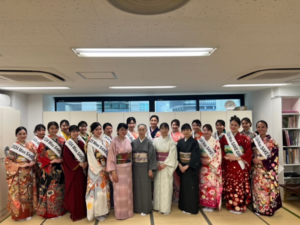Kimono Dressing Workshop:
Ethnic Costume Culture Promotion Association (Tokyo Nihonbashi Classroom)
Hello, everyone.
For the second day of the Nadeshiko Program, we had a kimono dressing training. In the morning, we moved from Ishikawa Sake Brewery in Fussa City, Tokyo, where we were staying, to the Ethnic Costume Culture Promotion Association near Tokyo Station.
During the short kimono dressing workshop the day before, I couldn’t dress as well as I had hoped and felt anxious going into the second day.
Teachers advised us individually while observing everyone’s condition, and we progressed by checking each movement for dressing kimono.
We took photos of how to tie the obi (belt) and took notes, desperately trying to be able to dress by ourselves from the next day.
With everyone’s help, we managed to dress, but I felt that self-practice at home is essential.
The kimono is Japan’s traditional attire, and from my previous experiences, I know that people from overseas greatly appreciate it when worn abroad. I want to learn to dress quickly and beautifully.
In the past, when there were occasions for international exchanges or formal events where traditional attire, suits, or dresses were specified, I couldn’t dress kimono myself, so I didn’t choose to bring a kimono.
However, from now on, I want to try to participate wearing a kimono as much as possible.
Compared to traditional attire from other countries, the kimono requires many tools and takes time to put on many layers carefully, including the collar. However, the combination of colors and patterns of the kimono and obi can be enjoyed in many ways, and I felt proud that it is such a beautiful traditional attire.
I want to pursue these two deep aspects of Japanese culture—sake and kimono—so much so that I can say, “My hobbies are sake and kimono.”
2024 Miss SAKE Tottori
Yuka Hayashibara
